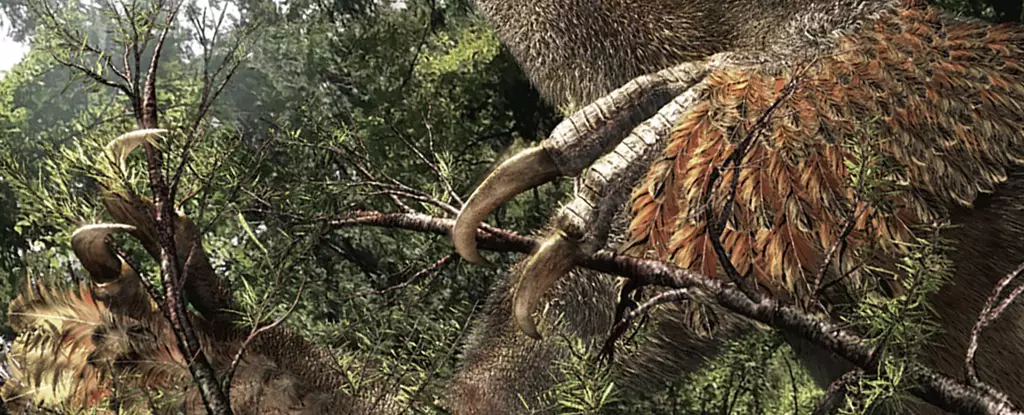In a groundbreaking find, paleontologists have unearthed a new species of feathered, bipedal dinosaur named Duonychus tsogtbaatari, remarkable not only for its distinctive appearance but also for its evolutionary implications. Discovered in the Bayanshiree Formation of southeastern Mongolia, this fossil turns the spotlight onto a unique evolutionary characteristic: instead of the typical three fingers common to most therizinosaurs, this dinosaur boasts an extraordinary set of two elongated, claw-tipped digits. The fossil, preserved in Cretaceous sediment, reveals intricacies such as the well-defined keratin sheaths encasing its claws, resembling talons much likened to a fearsome predator, yet it belonged to a genus known for its herbivorous tendencies.
Phenomenal Features: Claws that Defy Expectations
The claws of Duonychus tsogtbaatari measure nearly 30 centimeters long, an impressive size that mirrors those of modern predatory birds. However, their design indicates a departure from outright predation. While they may appear intimidating, researchers propose that these claws facilitated a different kind of interaction with the environment, perhaps aiding in grasping and pulling vegetation toward its mouth. The discovery challenges conventional views that associate specific bodily features strictly with certain behaviors.
The presence of only two fingers raises questions about the evolutionary pathway of therizinosaurs. Traditionally, this clade has been characterized by their three-fingered limbs; Duonychus’s departure from this norm evokes curiosity. What evolutionary pressures led to the reduction of one digit? Could this indicate a shift in feeding habits, or perhaps a response to ecological changes during the Cretaceous period? This discovery could underscore a broader narrative on adaptation, where sometimes, less is indeed more.
Dinosaur Archaeology: The Treasure Trove in the Gobi Desert
The Gobi Desert has long been a hotspot for paleontological finds, and its arid conditions have preserved a plethora of fossils dating back millions of years. This location was christened as a treasure for scientists, with findings ranging from massive dinosaur footprints to the awe-striking ‘fighting dinosaurs.’ The Bayanshiree Formation is particularly noteworthy, providing a wealth of specimens, including the remarkable Duonychus.
Researchers emphasize that the conditions within the Gobi Desert have played a pivotal role in the preservation of the unique structures found in fossils, such as the keratin sheaths that are typically fragile and seldom preserved. Such conditions offer a rare glimpse into the life of Cretaceous species and provide critical insights into their behavior and ecological roles.
Interpreting the Evolutionary Significance of Duonychus
The implications of Duonychus tsogtbaatari’s findings extend well beyond mere anatomical curiosity. The discovery conveys significant evolutionary insights, as it is the first therizinosaur identified with two fingers. The phenomenon of reduced digits is not unique within dinosauria, but to find this in a well-studied lineage merits close scrutiny. Current theories suggest that digit reduction could align with specialized feeding techniques or other survival strategies within their ecosystems.
Kobayashi, a leading researcher on this find, remarked that this well-preserved fossil opens avenues for understanding adaptive traits within dinosaurs. The versatility of Duonychus’s claws might suggest a multifaceted ecological role; not only were these structures fashioned for feeding, but they could also play a role in defense or mating rituals, showcasing the intricate web of life in Cretaceous ecosystems.
The Broader Implications for Paleobiology
Rather than simply shedding light on one dinosaur, Duonychus tsogtbaatari’s discovery elevates our understanding of theropod evolution as a whole. The rarity of two-fingered therizinosaurs invites a larger conversation about evolutionary paths across diverse environments. These findings compel paleontologists to reconsider traditional interpretations of digit functionality and adaptations, emphasizing how evolution often thrives in unexpected contexts.
Furthermore, as climate and environmental shifts continue to reshape our modern ecosystems, studying such evolutionary adaptations could provide crucial lessons about resilience and adaptability. Setting aside preconceived notions of how species should look or behave invites a broader and more inclusive understanding of the diversity of life on Earth.
The unveiling of Duonychus raises more questions than it answers, emblematic of the perpetual frontier that is paleontology. It challenges assumptions while paving the way for future discoveries that could fundamentally reshape our understanding of ancient life forms.

